Endodontic Treatment
Root Canal Treatment
Your tooth consists of two main parts: the crown (the part of the tooth above the gum and visible in your mouth) and the root (the part of the tooth that lies beneath the gum and is surrounded by bone). Inside each root is a channel that runs the length of the tooth. This channel is the root canal and contains the “pulp” (nerves, blood vessels, and soft tissue) of the tooth.
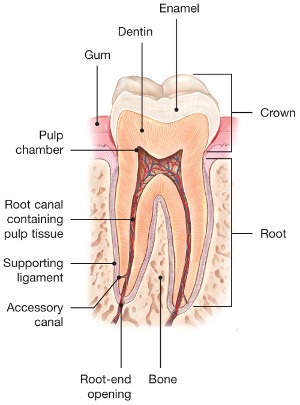
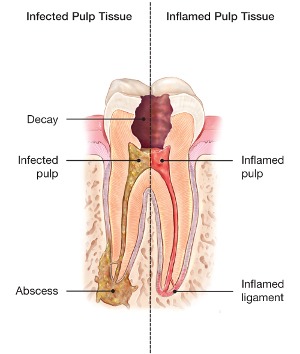
Your Treatment Plan
At Progressive Endodontics, your treatment plan begins with a diagnostic examination by one of our doctors to determine if root canal treatment is the most viable option for saving the tooth. After the determination is made, the injured pulp is removed and the root canal system is thoroughly cleaned and filled. New technologies allow us to perform a vast majority of root canal treatments in a single visit. However, for a small percentage of cases a second visit may be needed.
After treatment is complete, it is important for patients to contact their general dentist for a follow-up restoration appointment.
Step by Step Guide to Root Canals
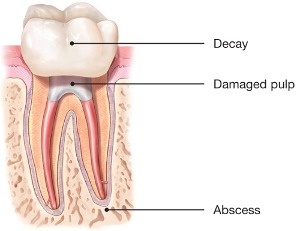
Step 1
The endodontist examines your tooth before administering local anesthesia. After the tooth is numb, the endodontist places a small protective sheet called a “dental dam” over the area to keep it sterile and isolated from saliva during the procedure.
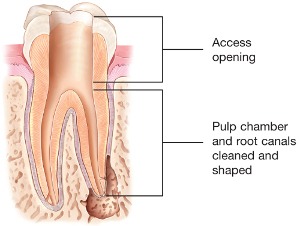
Step 2
After making an opening in the crown of the tooth, very small instruments are used to clean the pulp from the chamber and the root canals, and to shape the space for filling.
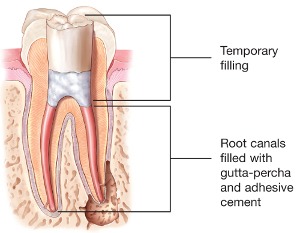
Step 3
Once the space is cleaned and shaped, the endodontist fills the root canals with a biocompatible material, usually a rubber-like substance called “gutta-percha.” Gutta-percha is placed with an adhesive cement to ensure complete sealing of the root canals. In most cases, a temporary filling is placed to close the opening. The temporary filling will be removed by your dentist before the tooth is restored.
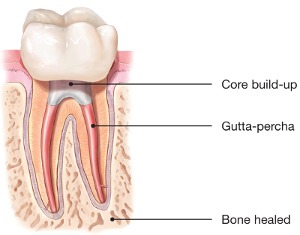
Step 4
After the final visit with your endodontist, you must return to your dentist to have a crown or other restoration placed on the tooth to protect and restore it to full function.
About Root Canal Safety
Cracked Teeth
Whether your tooth cracks from an injury or general wear and tear, you can experience a variety of symptoms ranging from erratic pain when you chew your food to sudden pain when your tooth is exposed to very hot or cold temperatures. In many cases, the pain may come and go and your dentist may have difficulty locating the tooth causing the discomfort. If you experience these symptoms or suspect a cracked tooth, it’s best to see an endodontist as soon as possible.
Endodontists specialize in saving cracked teeth and will cater treatment to the type, location, and extent of the crack. The sooner your tooth is treated, the better the outcome. Once treated, most cracked teeth continue to function as they should, for many years of pain-free biting and chewing.
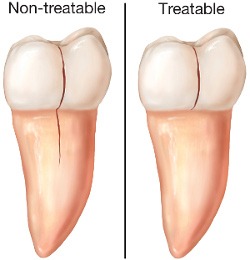
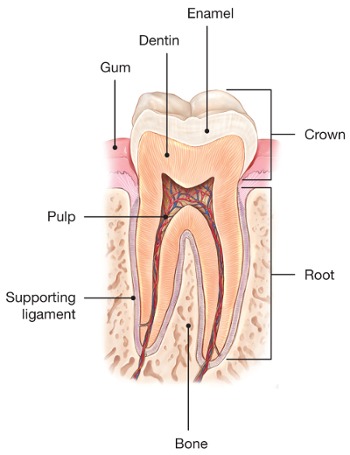
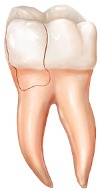
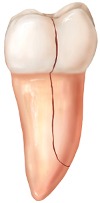
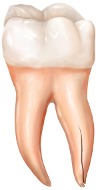
Cone Beam Computed Tomography
Cone beam computed tomography is an innovative medical imaging technique that provides endodontists with three-dimensional views of the patient. In certain cases, CBCT greatly enhances the endodontist’s ability to diagnose, evaluate, treat and care for patients.
During a CBCT scan, the machine rotates around the patient, capturing images using a cone-shaped X-ray beam. These images are then used to construct a 3-D representation of the patient’s teeth, oral and maxillofacial region (mouth, jaw, and neck), and ears, nose, and throat.
